It’s been a while since my last Taylor River fly fishing report and lots has changed on the river at Wilder. Currently the dry fly fishing is as good as it gets with BWO’s, Green Drakes, PMD’s, Stoneflies and clouds of Yellow Sallies and Caddis hatching throughout the day. River conditions are excellent and with the high Spring flows steadily dropping, more and more water is fishing well and fish are moving into the shallows and looking up. Water temperatures have been hovering right around 50 degrees which is perfect for the fish to be aggressive and the bugs to hatch.
Morning Fishing
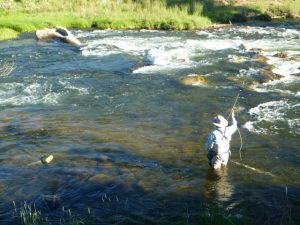 In the mornings there are clouds of Midges as well as Mayfly spinners and Caddis. In the right water fish can be found rising softly and a small dry fished very quietly can find some large fish. We have done well with a #22 Sierra Dot fished behind a #18 Yellow bodied Elk hair Caddis. These fish won’t be rising like crazy, every once in a while they’ll come up so be patient as you scan the water looking for a target.
In the mornings there are clouds of Midges as well as Mayfly spinners and Caddis. In the right water fish can be found rising softly and a small dry fished very quietly can find some large fish. We have done well with a #22 Sierra Dot fished behind a #18 Yellow bodied Elk hair Caddis. These fish won’t be rising like crazy, every once in a while they’ll come up so be patient as you scan the water looking for a target.
Mid-Day Fishing
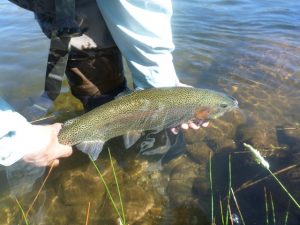 Around 11 a.m-noon, fish will start to rise more frequently as the bugs start to pop. You’ll also see egg laying Caddis dipping on the water and fish will be chasing them. Other fish will be sipping small Mayflies and a few are looking for a well presented giant Green Drake. Search in the foam lines and seams and try to figure out what the fish are eating.
Around 11 a.m-noon, fish will start to rise more frequently as the bugs start to pop. You’ll also see egg laying Caddis dipping on the water and fish will be chasing them. Other fish will be sipping small Mayflies and a few are looking for a well presented giant Green Drake. Search in the foam lines and seams and try to figure out what the fish are eating.
One technique that works very well for the next couple of weeks is skating a Caddis. Dress a size 14 or 16 Elk hair Caddis well, put it on a long 5x leader and cast across and slightly downstream. Hold your rod high and try to dance the fly lightly off the surface of the water. If the fly drowns, pull it back upstream and let it drift down again….repeat. When you get the hang of it you’ll be surprised at how many fish you will move.
Early Afternoon Fishing
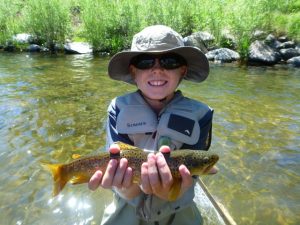 In the early afternoon is when you may see lots of Mayflies. Cloudy days are best. Recently between 1 and 4 pm there have been strong BWO, PMD and Flav (small Green Drake) hatches. Typically if the fish are eating Caddis you will see splashy rises, whereas if they are eating Mayflies, they will sip. They hammer the Big Green Drakes so watch the rise forms and choose your fly accordingly. That being said, at this time of year at Wilder, almost any dry fly you throw out there has a chance of being eaten by a wild trout.
In the early afternoon is when you may see lots of Mayflies. Cloudy days are best. Recently between 1 and 4 pm there have been strong BWO, PMD and Flav (small Green Drake) hatches. Typically if the fish are eating Caddis you will see splashy rises, whereas if they are eating Mayflies, they will sip. They hammer the Big Green Drakes so watch the rise forms and choose your fly accordingly. That being said, at this time of year at Wilder, almost any dry fly you throw out there has a chance of being eaten by a wild trout.
Evening Fishing
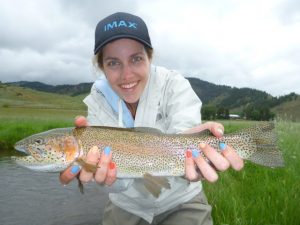 After 4-5pm, the Mayfly action dies out and you can pretty much fish Caddis imitations until dark. I like small Stimulators, Elk Hair Caddis, Para Caddis and Para Adams. Around 7:30 p.m. waves of Caddis travel up the river and it is one of the best times to be out there.
After 4-5pm, the Mayfly action dies out and you can pretty much fish Caddis imitations until dark. I like small Stimulators, Elk Hair Caddis, Para Caddis and Para Adams. Around 7:30 p.m. waves of Caddis travel up the river and it is one of the best times to be out there.
As usual, a soft presentation and good drift with a 9 foot plus 4X-6X leader is more important than a long cast. The softer that your fly hits the water and the better the drift is, the higher your odds of hooking into a Taylor River trophy trout.
If you feel the urge to fish a Dry/Dropper I’d recommend a #8 Golden Stone or Madame X as a dry with a 4 foot 5X dropper to a #14 Drake Nymph. If the larger Drake Nymph doesn’t produce, downsize the dropper fly to a size 16-20 Pheasant tail or micro May pattern.
Look for consistent afternoon hatches to continue and fish to keep rising through the month of July.
Fishing the Dream Stream
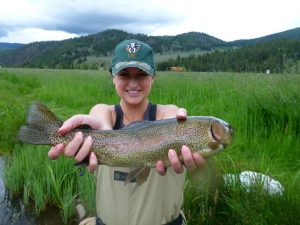 The Dream Stream has been fishing better than ever. Consistent hatches of Caddis BWO and Green Drake keep the fish very surface oriented and a number of dry flies, well presented can entice fish up the 8 pounds. The deeper pools typically hold the bigger Rainbows and small to medium sized Browns are everywhere in the riffles. Once in a while a fish will respond to a Hopper but it is still a little bit early in the summer for that. I am finding that Para Adams from size 12-18 and size 8 Green Drake patterns are irresistible to the fish when they aren’t spooked. When the fish do get spooked, that’s the time to either move on to other fish or tie on a small dropper such as a #18 bead head Pheasant tail. Make your first cast right down the center of the foam line and get ready because these fish can crush your fly the instant it touches the water. Do as much as possible to be sneaky and not let the fish know that you’re there. Move and cast quietly and you greatly will increase your odds of hooking a monster.
The Dream Stream has been fishing better than ever. Consistent hatches of Caddis BWO and Green Drake keep the fish very surface oriented and a number of dry flies, well presented can entice fish up the 8 pounds. The deeper pools typically hold the bigger Rainbows and small to medium sized Browns are everywhere in the riffles. Once in a while a fish will respond to a Hopper but it is still a little bit early in the summer for that. I am finding that Para Adams from size 12-18 and size 8 Green Drake patterns are irresistible to the fish when they aren’t spooked. When the fish do get spooked, that’s the time to either move on to other fish or tie on a small dropper such as a #18 bead head Pheasant tail. Make your first cast right down the center of the foam line and get ready because these fish can crush your fly the instant it touches the water. Do as much as possible to be sneaky and not let the fish know that you’re there. Move and cast quietly and you greatly will increase your odds of hooking a monster.
Fishing the Ponds at Wilder
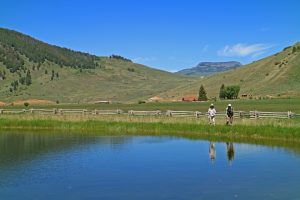 All Wilder ponds have fish that can break your tackle, so rig up well before hooking into a 10 pounder that will quickly find the weak point of your equipment and/or knots. This time of year they are eating Damselflies like crazy and you will see them eating the nymphs subsurface in the shallows as well as jumping up in the air to catch the adults. Not only is this entertaining to watch it can be some fun fishing. Tie on a Damsel on 2-3X, check your knot, re check your tippet/leader knots, sight the fish, make the cast and hang on. Of course it’s not always that easy but it certainly can be. If the dry doesn’t produce, either a Black or Olive Wooly Bugger size 10 or a Damsel nymph cast out and retrieved slowly can do the trick.
All Wilder ponds have fish that can break your tackle, so rig up well before hooking into a 10 pounder that will quickly find the weak point of your equipment and/or knots. This time of year they are eating Damselflies like crazy and you will see them eating the nymphs subsurface in the shallows as well as jumping up in the air to catch the adults. Not only is this entertaining to watch it can be some fun fishing. Tie on a Damsel on 2-3X, check your knot, re check your tippet/leader knots, sight the fish, make the cast and hang on. Of course it’s not always that easy but it certainly can be. If the dry doesn’t produce, either a Black or Olive Wooly Bugger size 10 or a Damsel nymph cast out and retrieved slowly can do the trick.
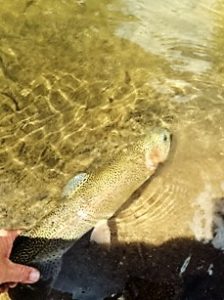 These are very big and very strong fish but do your best to land them quickly and take the time to revive them by working them back and forth in clean water and getting their gills moving. Try your best not to remove them from the water. Watch the fish as you release it and make sure it is right side up and stays that way. If the fish flips belly up, wade in, re-net it and revive it some more before letting it go.
These are very big and very strong fish but do your best to land them quickly and take the time to revive them by working them back and forth in clean water and getting their gills moving. Try your best not to remove them from the water. Watch the fish as you release it and make sure it is right side up and stays that way. If the fish flips belly up, wade in, re-net it and revive it some more before letting it go.
This is the best time of year for the fly fisherman in Colorado so I hope you all get out there, enjoy the fishing and do your best to take care of the fish and the beautiful places that they live.
Keep your backcasts tight and high.
Wilder on the Taylor River offers a unique opportunity to own private fly-fishing property along with a beautiful riverfront home. Click the links to learn more.









